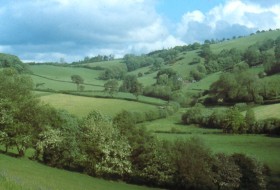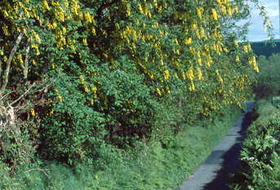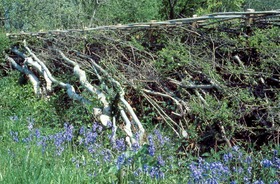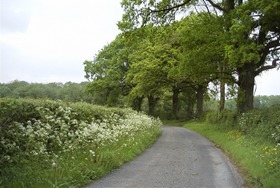Hedgerows
Page updated on: 17/04/2025
Creating a network of linear wildlife habitats, hedgerows are one of the features of the agricultural landscapes for which Britain is famous. In Europe hedges are only common in Normandy and parts of Brittany, in Northern Italy and Austria.
Carmarthenshire probably has one of the most complex networks of hedgerows of any part of Wales, and across the county our hedges are still maintained for agricultural purposes. As long-established features in the landscape, often providing a route between other habitats, they have become extremely rich in terms of the wildlife they support.
Hedgerows are essentially a man-made element of the landscape, and for generations they have enabled farmers to have more control over the way their land is grazed, and their animals managed. In addition those hedgerows positioned on banks, often provide much needed shelter for stock. Prior to the arrival of barbed wire and sheep netting, all hedgerows would have been maintained by hand, and appropriate management continues to be essential if they are to survive.
Successful hedgerow management for wildlife and landscape conservation is dependent on adopting a sensitive approach. While traditional hedge-laying, carried out in the winter months, will keep hedgerows in good heart and can give a new lease of life to a long-neglected hedge, many landowners today also use a mechanical flail to maintain some of their hedgerows.
If used carefully, at suitable times of year, and in conjunction with more traditional methods, these too can help keep a hedgerow in good condition. Suggested guidelines are set in the section 'Good Practice Guide for Hedgerow Management'.
Between 1984 and 1993 it is estimated that over one quarter of the total length of Welsh hedgerows was lost, with lack of management, often overgrazing, accounting for far greater losses than deliberate removal. Today, despite the Hedgerow Regulations 1997, and the introduction of whole farm Agri-environment schemes, losses continue for similar reasons. Within the UK Biodiversity Action Plan ancient and species-rich hedgerows are recognized as a priority habitat, in need of conservation.
In Carmarthenshire, the Local Nature Partnership aims to:
- Halt the loss of ancient and species-rich hedgerows
- Improve the condition of hedgerows as wildlife habitats
- Maintain and increase the number of hedgerow trees
Hedgerows are some of the oldest man-made features in the landscape, and some may also mark ancient boundaries. Archaeological evidence from sites in Britain suggests that hedgerows may have existed during the Roman period, and possibly in the Bronze Age. The vast majority of hedgerows in Carmarthenshire are considered to have been created in one of two ways: either they were formed as former woodland cover was cleared to make way for agricultural enclosures, or they were planted, usually on a bank.
John Clark, writing in 1794 on the state of agriculture in Breconshire, describes how best to establish a new hedge:
"When a new fence is to be made any kinds of under wood are grubbed up with the roots any time from November to March. These are immediately planted where the new hedge is meant to be made. Four feet is left for the foundation of the bank, the quicks being planted in the centre. A ditch is then dug on each side of the bank, and the earth thrown up to form this bank for three foot high.
If the quicks can be had five feet in length, there will be two feet above the top of the bank when finished, but as this cannot always be the case, one foot above the bank will soon make a good fence."
Hedge planting has taken place over several hundred years, and early planting made use of naturally occurring seedlings. It is likely that the 19th Century saw the greatest amount of new hedgerows emerging in the landscape. This was made possible by the development of tree nurseries such as at Ty Mawr near Llanybydder, which could supply large quantities of hedgerow plants including hawthorn, blackthorn, and beech.
In Carmarthenshire it was the fields at higher elevations, on what had been open, un-enclosed land, that were being hedged during this period. These hedgerows can be seen in the landscape today, typically where the field pattern is rectangular or geometric in comparison to the more irregular field shapes associated with the lower lying areas, which are usually considered to be of earlier origin.
Old maps such as the Tithe Maps, and estate records can tell us about the history of field patterns, and from these we can deduce that the vast majority of the landscape of rural Carmarthenshire that we see today, was in place by 1845.
Maps also indicate where changes in the field pattern have subsequently taken place. There are farms in the Tywi Valley where, during the second half of the 19th century an older field pattern was replaced by something more geometric and more ordered, presumably following the fashion of the day.
Carmarthenshire’s hedgerows typically consist of a wide variety of woody shrubs. However on some of the higher land, some hedgerows consist almost exclusively of laburnum (Laburnum anagyroides and L. alpinum). It is thought that at some time in the 19th century a supply of this somewhat unusual hedging plant became available. Similar hedgerows and be found in Ceredigion and north-east Pembrokeshire.
While much of the elm in the county has succumbed to Dutch Elm Disease, elm continues to thrive in hedgerows in some parts of the county, such as on the Llanelli Levels and in parts of the Tywi Valley. As a hedgerow shrub, rather than a tree, it is usually too small to host the wood-boring beetles that carry the fatal disease.
It is important that elm rich hedgerows are cut back or laid from time to time, to ensure the survival of this species in the county. Wych elm is the food plant for the white-letter hairstreak, an elusive butterfly that can still be found in parts of the county.
Across Carmarthenshire hedgerows provide a rich and varied wildlife habitat. They offer shelter, a supply of food, and a route linking different habitats along which wildlife can travel. If we look closely at a hedgerow we can see that in fact it provides for wildlife in many ways.
Hedgerows and Birds
The British Trust for Ornithology has carried out research demonstrating that hedgerows are particularly important for some of our farmland birds, including goldfinch, whitethroat, and greenfinch, while other species are more frequently associated with woodlands.
Hedges and woodlands appear to support different birds. The structure of a hedgerow will also influence the types of birds it supports - and a variety of hedgerow types will, in turn, support wide variety of birds.
Blackbirds, robins and wrens all prefer hedgerows that are thick right down to their base, whereas little owls like hedgerows with tall trees, in which to nest and from which to hunt. Hedgerows are an important hunting ground for Sparrowhawks, often seen flying fast and low alongside a hedge.
Tall grassy areas and brambles at the base of a hedgerow support high populations of small mammals making them good hunting places for barn owl. Fencing out of hedgerows, and placing the fence one pace from the base of the bank, achieves this goal.
Small mammals and insects
In Carmarthenshire, blackthorn hedgerows are crucial for the survival of the brown hairstreak butterfly. These butterflies lay their eggs on 3 and 4-year-old blackthorn in late summer. When the leaves open in May it is on this plant that the caterpillar feeds.
Many small mammals feed and shelter in hedgerows. They will also use hedgerows when travelling from one area to another. Remove the hedgerows from a landscape and many of the small mammals will disappear as well.
Hedgerows are rich in insects and are consequently important feeding areas for bats.
It is vitally important that hedgerows supporting this butterfly are not trimmed every year, but that they are cut on a longer rotation, ideally every 3 or 4 years, to provide the necessary habitat.
Hedgerow trees add another dimension to the wildlife a hedgerow supports, adding a number of mini habitats not usually found in a hedgerow, such as standing dead wood, holes for nesting bird and bat roosts, mature bark which may support lichens, mosses, ferns, and ivy, as well as a huge canopy, important for a range of insects. These trees are extremely important features in the landscape, and hedgerow management should be designed to conserve those that are present and to allow the establishment of new hedgerow trees.
The woody shrubs and trees most frequently recorded in Carmarthenshire’s hedgerows are:
- Hawthorn
- Hazel
- Wild Rose
- Ash
- Holly
- Blackthorn
- Oak
- Willow
- Sycamore
- Rowan
When planting new hedges or filling gaps in old, aim to use transplants grown from locally collected seed. Use a similar mix of species to that in the hedgerows nearby, as these are the species most likely to thrive. Protect from stock and the flail. Remember to mulch young plants as this will increase their chances of survival and rates of growth.
- Look after all hedgerows on your land. They need not all be managed in the same way and ideally some should be allowed to become wide tall hedgerows.
- Identify those hedgerows that may need to be laid, and aim to carry out a proportion of this work every year over a number of years, e.g.10 years.
- Retain existing hedgerow trees and identify and safeguard those that will be the trees of the future. Plant new saplings where none are present. Protect and mark these so that no one forgets what they are for! Birds will use these young trees as song posts.
- Stock can damage hedgerows by browsing and trampling. New re-growth after hedge-laying is particularly vulnerable. When fencing to protect a hedgerow from stock, place the fence at least one large pace from the base of the bank. This will allow the shrubby growth to develop on the bank while creating an area of tall grasses at its base. This is an important habitat for small mammals and insects, and one that is often lacking in tightly grazed fields.
- Aim to avoid annual flailing of all your hedgerows. Where possible flail every 2 or 3 years. If you have lots of blackthorn in your hedgerows, there is a possibility that brown hairstreak butterflies may use these, so avoid flailing altogether or cut every 3 or 4 years to ensure a supply of 3-year-old blackthorn for the butterfly. Seek advice from Butterfly Conservation.
- Hedgerows and dormice. If the hedgerow is rich in hazel and honeysuckle keep an eye out for signs of dormice – they eat their favourite food, hazel nut, in a particular way. Dormice are a European protected species. Seek advice from Natural Resources Wales.
- Leave some of your hedgerows uncut until February, so wildlife can enjoy this feast. The berries in the hedgerows provide an important source of food for birds and small mammals over the winter months.
- Look after nesting birds. Avoid carrying out any hedgerow work during the nesting season – March – July.
- Nest boxes placed in hedgerow trees are usually quickly occupied. Tie these on with an old bicycle inner tube or similar, rather than using nails.
- If you need to replant a section of a hedgerow, aim to use transplants grown from locally collected seed. Use a similar mix of species to that in other hedgerows nearby, these are the species most likely to thrive. Protect from stock and the flail.
- Create a 2m wide fertilizer and herbicide free buffer zone adjacent to your hedgerows.
